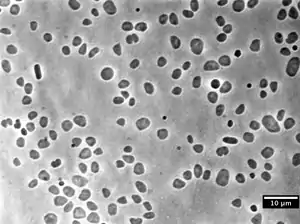Haloferax
Haloferax ist eine Gattung der Familie Haloferacaceae (LPSN[1] und NCBI[2]); früher wurde die Gattung in die Familie Halobacteriaceae gestellt.[3]
| Haloferax | ||||||||||||
|---|---|---|---|---|---|---|---|---|---|---|---|---|

Haloferax volcanii | ||||||||||||
| Systematik | ||||||||||||
| ||||||||||||
| Wissenschaftlicher Name | ||||||||||||
| Haloferax | ||||||||||||
| Torreblanca et al. 1986 |
Nach einer umfassenden Studie über extrem halophile Halobacteria wurden 1986 zwei der untersuchten Stämme als neue Arten charakterisiert, Haloarcula hispanica (Stamm Y27 alias ATCC 33960) und Haloferax gibbonsii (Stamm MA2.38 alias ATCC 33959).[4]
Das Genom von Haloferax massiliense wurde 2018 sequenziert.[5]
Genetischer Austausch
Zellen von Haloferax mediterranei und Zellen der verwandten Spezies Haloferax volcanii[6] können einen genetischen Austausch zwischen zwei Zellen durchlaufen (horizontaler Gentransfer, HGT).[7]
Obwohl ein solcher genetischer Austausch normalerweise zwischen zwei Zellen derselben Spezies stattfindet, kann er auch mit niedrigerer Frequenz zwischen einer H. mediterranei- und einer H. volcanii-Zelle auftreten. Die beiden Spezies haben eine durchschnittliche Nucleotidsequenz-Übereinstimmung von 86,6 %.[7] Während dieses Austauschprozesses fusionieren zwei Zellen zu einer heterodiploiden Zelle, welche die beiden verschiedenen Chromosomen und somit das gesamte genetische Repertoire der beiden parentalen Zellen enthält. Dadurch wird die genetische Rekombination gefördert. Anschließend trennen sich die Zellen, wobei rekombinante Zellen entstehen können.
Siehe auch
Weiterführende Literatur
- A. Oren, A. Ventosa: International Committee on Systematic Bacteriology Subcommittee on the taxonomy of Halobacteriaceae. Minutes of the meetings, 16 August 1999, Sydney, Australia. In: International journal of systematic and evolutionary microbiology. Band 50 Pt 3, Mai 2000, S. 1405–1407, doi:10.1099/00207713-50-3-1405, PMID 10843089.
- Marina Torreblanca, F. Rodriguez-Valera, Guadalupe Juez, Antonio Ventosa, Masahiro Kamekura, Morris Kates: Classification of Non-alkaliphilic Halobacteria Based on Numerical Taxonomy and Polar Lipid Composition, and Description of Haloarcula gen. nov. and Haloferax gen. nov. In: Systematic and Applied Microbiology. 8, 1986, S. 89, doi:10.1016/s0723-2020(86)80155-2.
Einzelnachweise
- Liste prokaryotischer Namen LPSN, List of prokaryotic names with standing in nomenclature
- Taxonomy browser des NCBI, ID 2251, National Center for Biotechnology Information
- Radhey S. Gupta, Sohail Naushad, Sheridan Baker: Phylogenomic analyses and molecular signatures for the class Halobacteria and its two major clades: a proposal for division of the class Halobacteria into an emended order Halobacteriales and two new orders, Haloferacales ord. nov. and Natrialbales ord. nov., containing the novel families Haloferacaceae fam. nov. and Natrialbaceae fam. nov. In: International Journal of Systematic and Evolutionary Microbiology. Band 65, Pt 3, März 2015, ISSN 1466-5034, S. 1050–1069, doi:10.1099/ijs.0.070136-0, PMID 25428416.
- Guadalupe Juez, F. Rodriguez-Valera, Antonio Ventosa, Donn J. Kushner: Haloarcula hispanica spec. nov. and Haloferax gibbonsii spec. nov., two new species of extremely halophilic archaebacteria. In: Syst. Appl. Microbiol., Band 8, 1986, S. 75–79.
- Saber Khelaifia, Aurelia Caputo, Claudia Andrieu, Frederique Cadoret, Nicholas Armstrong, Caroline Michelle, Jean-Christophe Lagier, Félix Djossou, Pierre-Edouard Fournier, Didier Raoult: Genome sequence and description of Haloferax massiliense sp nov., a new halophilic archaeon isolated from the human gut. In: Extremophiles, Springer Verlag, Band 22, Nr. 3, 2018, S. 485–498, doi:10.1007/s00792-018-1011-1, hal-01780673
- Bernhard Tschitschko et al.: Genomic variation and biogeography of Antarctic haloarchaea, in: Microbiome, Band 6, Nr. 113, 2018; doi:10.1186/s40168-018-0495-3.
Ricardo Cavicchioli: Behind the paper: Antarctic haloarchaea – a unique Microbiome, in: Microbiology, 19. Juni 2018. - A. Naor, P. Lapierre, M. Mevarech, R. T. Papke, U. Gophna: Low species barriers in halophilic archaea and the formation of recombinant hybrids. In: Current biology : CB. Band 22, Nummer 15, August 2012, S. 1444–1448, doi:10.1016/j.cub.2012.05.056, PMID 22748314.